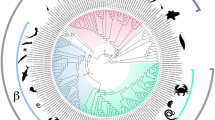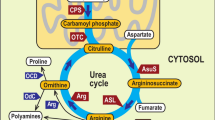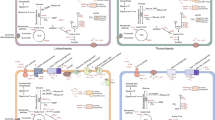Abstract
l-Lactate/malate dehydrogenases (LDH/MDH) and type 2 l-lactate/malate dehydrogenases (LDH2/MDH2) belong to NADH/NADPH-dependent oxidoreductases (anaerobic dehydrogenases). They form a large protein superfamily with multiple enzyme homologs found in all branches of life: from bacteria and archaea to eukaryotes, and play an essential role in metabolism. Here, we describe the gene encoding a new enzyme of LDH2/MDH2 oxidoreductase family. This gene is found in genomes of all studied groups/classes of bacteria and fungi. In the plant kingdom, this gene was observed only in algae, but not in bryophyta or spermatophyta. This gene is present in all taxonomic groups of animal kingdom beginning with protozoa, but is lost in lungfishes and other, higher taxa of vertebrates (amphibians, reptiles, avians and mammals). Since the gene encoding the new enzyme is found only in taxa associated with the aquatic environment, we named it AqE (aquatic enzyme). We demonstrated that AqE gene is convergently lost in different independent lineages of animals and plants. Interestingly, the loss of the gene is consistently associated with transition from aquatic to terrestrial life forms, which suggests that this enzyme is essential in aquatic environment, but redundant or even detrimental in terrestrial organisms.



Similar content being viewed by others
References
Albalat R, Cañestro C (2016) Evolution by gene loss. Nat Rev Genet 17(7):379–391
Altschul SF, Madden TL, Schäffer AA, Zhang J, Zhang Z, Miller W et al (1997) Gapped BLAST and PSI-BLAST: a new generation of protein database search programs. Nucleic Acids Res 25:3389–3402
Clark AG, Eisen MB, Smith DR, Bergman CM, Oliver B, Markow TA et al (2007) Evolution of genes and genomes on the Drosophila phylogeny. Nature 450(7167):203–218
Danovaro R, Dell’Anno A, Pusceddu A, Gambi C, Heiner I, Kristensen RM (2010) The first metazoa living in permanently anoxic conditions. BMC Biol 8:30
Denger K, Cook AM (2010) Racemase activity effected by two dehydrogenases in sulfolactate degradation by Chromohalobacter salexigens: purification of (S)-sulfolactate dehydrogenase. Microbiology 156:967–974
Drouin G, Godin JR, Pagé B (2011) The genetics of vitamin C loss in vertebrates. Curr Genom 12(5):371–378. https://doi.org/10.2174/138920211796429736
Edgar RC (2004) MUSCLE: multiple sequence alignment with high accuracy and high throughput. Nucleic Acids Res 32:1792–1797
Gewin V (2010) Dead in the water. Nature 466(7308):812–814
Goldman-Huertas B, Mitchell RF, Lapoint RT, Faucher CP, Hildebrand JG, Whiteman NK (2015) Evolution of herbivory in Drosophilidae linked to loss of behaviors, antennal responses, odorant receptors, and ancestral diet. Proc Natl Acad Sci USA 112:3026–3031
Graupner M, Xu H, White RH (2000) Identification of an archaeal 2-hydroxy acid dehydrogenase catalyzing reactions involved in coenzyme biosynthesis in methanoarchaea. J Bacteriol 182:3688–3692
Greenberg AJ, Moran JR, Coyne JA, Wu CI (2003) Ecological adaptation during incipient speciation revealed by precise gene replacement. Science 302:1754–1757
Hochachka PW, Somero GN (2002) Biochemical adaptation: mechanisms and process of physiological evolution. Oxford Univesity Press, New York
Honka E, Fabry S, Niermann T, Palm P, Hensel R (1990) Properties and primary structure of the l-malate dehydrogenase from the extremely thermophilic archaebacterium Methanothermus fervidus. Eur J Biochem 188(3):623–632
Irimia A, Madern D, Vellieux FMD (2004) Methanoarchaeal sulfolactate dehydrogenase: prototype of a new family of NADH-dependent enzymes. EMBO J 23:1234–1244
Isani G, Cattani O, Tacconi S, Carpene E, Cortesi P (1986) Energy metabolism during anaerobiosis and the recovery of the posterior adductor muscle of Scapharca inaequivalvis. Nova Thalass 8(3):575–576
Källberg M, Wang H, Wang S, Peng J, Wang Z, Lu H et al (2012) Template-based protein structure modeling using the RaptorX web server. Nat Protoc 7:1511–1522
Klyashtorin LB (1982) Water respiration and oxygen demands of fishes. Legkaya and Pishchevaya Promyshlennost, Мoscow (in Russian)
Kumar S, Stecher G, Tamura K (2016) MEGA7: molecular evolutionary genetics analysis version 7.0 for bigger datasets. Mol Biol Evol 33:1870–1874
Levin L (2003) Oxygen minimum zone benthos: adaptation and community response to hypoxia. Oceanogr Mar Biol Annu Rev 41:1–45
Marchler-Bauer A, Bo Y, Han L, He J, Lanczycki CJ, Lu S et al (2017) CDD/SPARCLE: functional classification of proteins via subfamily domain architectures. Nucleic Acids Res 45(D):200–203
McBride CS, Arguello JR, O’Meara BC (2007) Five Drosophila genomes reveal nonneutral evolution and the signature of host specialization in the chemoreceptor superfamily. Genetics 177:1395–1416
Middelburg JJ, Levin LA (2009) Coastal hypoxia and sediment biogeochemistry. Biogeosci Discuss 6(2):3655–3706
Mommsen TP, French CJ, Hochachka PW (1980) Sites and patterns of protein and amino acid utilization during the spawning migration of salmon. Can J Zool 58(10):1785–1799
Moreau R, Dabrowski K (1998) Body pool and synthesis of ascorbic acid in adult sea lamprey (Petromyzon marinus): an agnathan fish with gulonolactone oxidase activity. Proc Natl Acad Sci USA 95:10279–10282
Nei M, Kumar S (2000) Molecular evolution and phylogenetics. Oxford University Press, New York
Saitou N, Nei M (1987) The neighbor-joining method: A new method for reconstructing phylogenetic trees. Mol Biol Evol 4:406–425
Soldatov AA, Savina MV (2008) Effect of hypoxia on the content and stoichiometry of cytochromes in muscle of the gray mullet Liza aurata. J Evol Biochem Physiol 44(5):599–604
Soldatov AA, Andreenko TI, Sysoeva IV, Sysoev AA (2009) Tissue specificity of metabolism in the bivalve mollusc Anadara inaequivalvis Br. under conditions of experimental anoxia. J Evol Biochem Physiol 45(3):349–355
Stedman HH, Kozyak BW, Nelson A, Thesier DM, Su LT, Low DW et al (2004) Myosin gene mutation correlates with anatomical changes in the human lineage. Nature 428:415–418
Stoeck T, Taylor GT, Epstein SS (2003) Novel eukaryotes from the permanently anoxic Cariaco Basin (Caribbean Sea). Appl Environ Microbiol 69(9):5656–5663
Wang S, Li W, Liu S, Xu J (2016) RaptorX-Property: a web server for protein structure property prediction. Nucleic Acids Res 44(W1):W430–W435
Zhang Z, Schwartz S, Wagner L, Miller W (2000) A greedy algorithm for aligning DNA sequences. J Comput Biol 7(1–2):203–214
Acknowledgements
This study was supported by the Russian Academy of Sciences Research Grant No. AAAA-A18-118021490093-4.
Author information
Authors and Affiliations
Corresponding author
Ethics declarations
Conflict of interest
The authors declare that they have no conflict of interest.
Electronic supplementary material
Below is the link to the electronic supplementary material.
Rights and permissions
About this article
Cite this article
Puzakova, L.V., Puzakov, M.V. & Soldatov, A.A. Gene Encoding a Novel Enzyme of LDH2/MDH2 Family is Lost in Plant and Animal Genomes During Transition to Land. J Mol Evol 87, 52–59 (2019). https://doi.org/10.1007/s00239-018-9884-2
Received:
Accepted:
Published:
Issue Date:
DOI: https://doi.org/10.1007/s00239-018-9884-2




